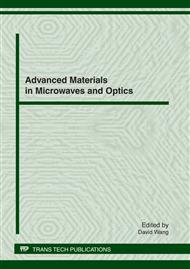[1]
C. G. Caro and J. A. Bloice, Contactless apnoea detector based on radar, Lancet, vol. 2, Oct. 1971, pp.959-961.
DOI: 10.1016/s0140-6736(71)90274-1
Google Scholar
[2]
C. I. Franks, B. H. Brown, and D. M. Johnston, Contactless respiration monitoring of infants, Med. Bio. Eng., vol. 14, May. 1976, pp.306-312, doi: 10. 1007/BF02478126.
DOI: 10.1007/bf02478126
Google Scholar
[3]
Y. Schutz, E. Ravussin, R. Diethelm, and E. Jequier, Spontaneous physical activity measured by radar in obese and control subject studied in a respiration chamber, Int. J. Obes., vol. 6, Jan. 1982, pp.23-28.
Google Scholar
[4]
G. Matthews, B. Sudduth, and M. Burrow, A non-contact vital signs monitor, Crit. Rev. Biomed. Eng., vol. 28, Jan. 2000, pp.173-178.
DOI: 10.1615/critrevbiomedeng.v28.i12.290
Google Scholar
[5]
M. Uenoyama, T. Matsui, K. Yamada, S. Suzuki, B. Takase, S. Suzuki, M. Ishihara, and M. Kawakami, Non-contact respiratory monitoring system using a ceiling-attached microwave antenna, Med. Biol. Eng. Comput., vol. 44, Sep. 2006, pp.835-840.
DOI: 10.1007/s11517-006-0091-8
Google Scholar
[6]
K. M. Chen, Y. Huang, J. Zhang, and A. Norman, Microwave cardiopulmonary signs monitoring systems for searching human subjects under earthquake rubble or behind barrier, IEEE Trans. Biomed. Eng., vol. 47, , Jan. 2000, pp.105-114.
DOI: 10.1109/10.817625
Google Scholar
[7]
C. W. Wu and Z. Y. Huang, Using the phase change of a reflected microwave to detect a human subject behind a barrier, IEEE Trans. Biomed. Eng., vol. 55, Jan. 2008, pp.267-272, doi: 10. 1109/TBME. 2007. 910680.
DOI: 10.1109/tbme.2007.910680
Google Scholar
[8]
M. Brink, C. H. Muller, and C. Schierz, Contact-free measurement of heart rate, respiration rate, and body movements during sleep, Behav. Res. Meth., vol. 38, Aug. 2006, pp.511-521.
DOI: 10.3758/bf03192806
Google Scholar
[9]
H. J. Kim, K. H. Kim, Y. S. Hong, and J. J. Choi, Measurement of human heartbeat and respiration signals using phase detection radar, Rev. Sci. Instrum., vol. 78, Oct. 2007, p.104703, doi: 10. 1063/1. 2798937.
DOI: 10.1063/1.2798937
Google Scholar
[10]
K. H. Chan and J. C. Lin, Microprocessor-based cardiopulmonary rate monitor, Med. Biol. Eng. Comput., vol. 25, Jan. 1987, pp.41-44, doi: 10. 1007/BF02442818.
DOI: 10.1007/bf02442818
Google Scholar
[11]
J. Q. Wang, C. X. Zheng, X. J. Jin, G. H. Lu, H. B. Wang, and A. S. Ni, Study on a non-contact life parameter detection system using millimeter wave, Space Med. Med. Eng., vol. 17, Jun. 2004, pp.157-161.
Google Scholar


